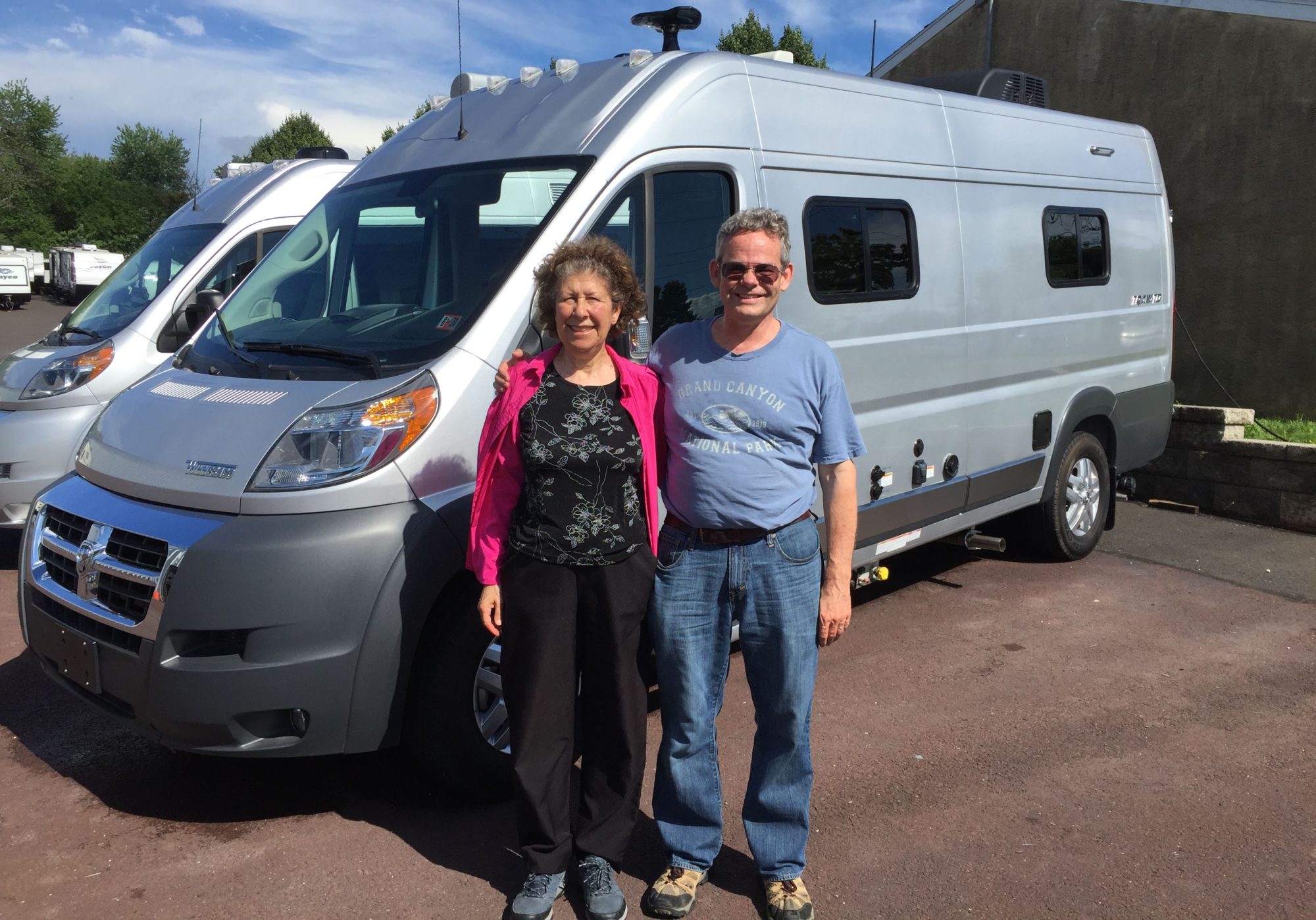Albuquerque (Nov. 7)
If you are a late riser like us, driving west is a problem. In the early afternoon, you find you are driving straight into the sun. The problem was exacerbated for us due to the change back to standard time on the weekend. We learned our lesson coming into Amarillo, and decided to leave very early on the way out. As a result, we were on the road by 8 a.m., stopped for breakfast en route, and were camped in Albuquerque in time for lunch.
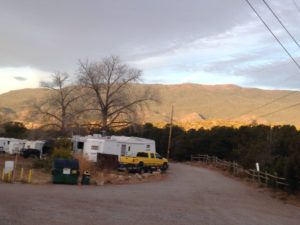 Our campground, Hidden Valley, is actually to the east of Albuquerque in the town of Zuzax, (love the name!) just east of the Sandia Mountains. There was not much space between sites, but the campground had a good view of the mountains, a nice lounge, free coffee and a large book exchange. (I ended up with 7 new books.)
Our campground, Hidden Valley, is actually to the east of Albuquerque in the town of Zuzax, (love the name!) just east of the Sandia Mountains. There was not much space between sites, but the campground had a good view of the mountains, a nice lounge, free coffee and a large book exchange. (I ended up with 7 new books.)
Another problem of driving west, particularly with the end of Daylight Saving Time and a stubborn dog, is that we needed to turn our clocks back by 2 hours. Rumple’s attitude, of course, is that there is no need to adjust to an arbitrary clock. So he now wants his evening walk around supper time, and is quite disgusted that we do not want to head for bed around 9 p.m. On the other hand, at 6:30 a.m. he feels his morning walk is very overdue (and we are lucky that over the last few months he was getting up later – otherwise he would be feeling perky at 5 a.m.) Since it now gets dark at 5, and most museums also close around then, we would probably be better off following Rumple’s example. But of course we reset the clocks and our schedules.
My new habit has been to call up all the knitting places as we pulled into town, in the seemingly hopeless task of finding the 11 balls of yarn needed for Elisabeth’s sweater. Happily one store said they had 9 balls and another had 5. I decided that this was the best I was going to do, as even special orders would not guarantee a single dye lot.
In the morning, I drove into Albuquerque and picked up my 9 balls of yarn from one store and 3 (just to be safe) from the other. Astonishingly, they were from the same dye lot. The next day I decided I needed a bigger margin of error, so I picked up the last 2 balls. So, I ended up with 14 balls of yarn from the same dye lot and have been knitting away ever since. Anyone in Albuquerque who is interested in this particular yarn is going to be out of luck until the next shipment comes in.
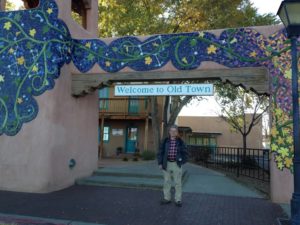 The yarn excursion took up the entire morning. For the afternoon, we visited the Old Town of Albuquerque. This is the oldest part of the town, built around the old plaza and church. The buildings all look very Mexican, and have mostly been converted to restaurants and tourist shops.
The yarn excursion took up the entire morning. For the afternoon, we visited the Old Town of Albuquerque. This is the oldest part of the town, built around the old plaza and church. The buildings all look very Mexican, and have mostly been converted to restaurants and tourist shops.
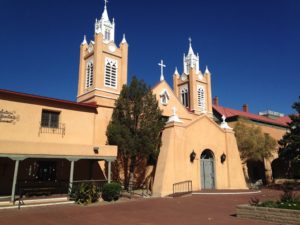 We spent some time wandering around and admiring the old buildings, as well as dropping by the Tourist Information Center, where the friendly volunteers gave us advice about the local attractions.
We spent some time wandering around and admiring the old buildings, as well as dropping by the Tourist Information Center, where the friendly volunteers gave us advice about the local attractions.
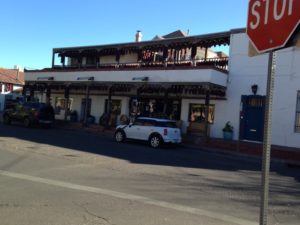 Decorating with strings of red peppers is definitely the thing here. As well, there are lots of small alley ways opening up to small plazas crowded with shops.
Decorating with strings of red peppers is definitely the thing here. As well, there are lots of small alley ways opening up to small plazas crowded with shops.
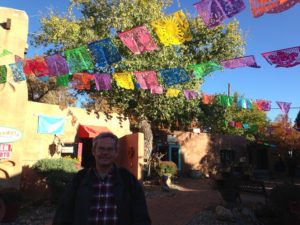
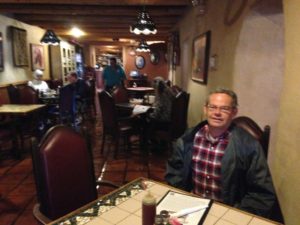
For lunch we went to a restaurant that is situated in what was once one of the oldest homes in the area. It was well worth it just for the ambience, as it retained the interior architecture and was beautifully furnished.
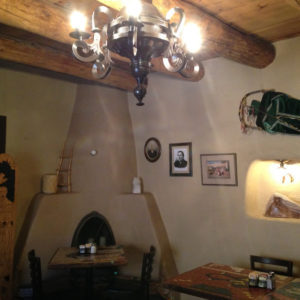
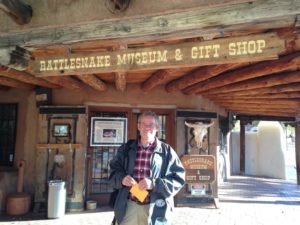
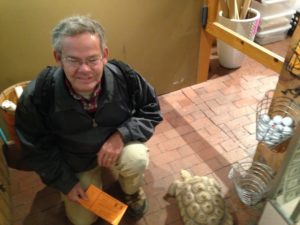
After lunch, we decided to go to the Rattlesnake Museum. As advertised, it was full of live rattlers of various types – we had no idea that there were so many types of varying sizes. Other wildlife – most other snakes and reptiles – were also featured, including a couple of tortoises that were always under foot. As well, they had a nice collection of art and artifacts with snake themes.
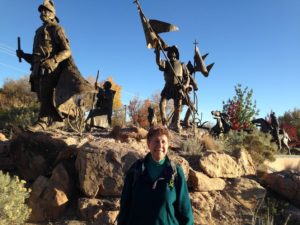 By the time we were done, it was rather late to go to the Albuquerque Museum. (I was there for a conference, and it has a great art collection.) However, the museum gardens are open and free. They have a monument to the Spanish settlement of Albuquerque which is on a scale similar to the Oklahoma City Land Rush monument.
By the time we were done, it was rather late to go to the Albuquerque Museum. (I was there for a conference, and it has a great art collection.) However, the museum gardens are open and free. They have a monument to the Spanish settlement of Albuquerque which is on a scale similar to the Oklahoma City Land Rush monument.
With a work day on Friday, we were eager to get back to sightseeing on Friday. There is a back route from Albuquerque to Los Alamos that follows Jemez Creek as it goes through the mountains and includes many scenic and historic sites. We decided to follow the route, stopping at sites of interest as we went.
We started out at the Coronado Historic Site and Kauau Pueblo archeological site. Around 1540, The Spanish “explorer” Coronado searching for the fabled (and non-existent) cities of gold, followed the Rio Grande with retinue of about 2500 Spanish and native American soldiers and arrived in the Albuquerque area. There he found several villages of Tiwa Indians. Whether willingly or by force, the Tiwas (whose villages, including women and children were quite outnumbered by the Spanish) fed and housed Coronado and his retinue. Eventually the Tiwas resisted. I do not recall all the details, but within a few decades, the Kauau Pueblo was abandoned until archeological excavations were started in the 1930s.
The Pueblo on the shores of the Rio Grande was apparently first occupied in the 1300’s, and there may have subsequent immigration and absorption by other groups, as evidenced by artifacts at the site. The site includes several kivas (underground ceremonial sites) of various designs. Visitors can wander along the trail going through the pueblo, but to visit the famous painted kiva you must go with a park docent.
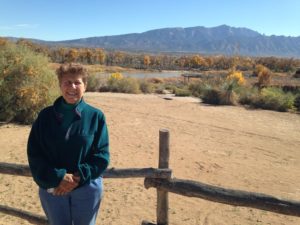 Due to a lull in the stream of visitors, we had a docent to ourselves. She showed us how artifacts are constantly rising to the surface, from pottery fragments to pieces of metate to shards of flint. She also noted several types of vegetation that grow wild in the area but that were very useful to the native peoples as foods, fibers and building materials.
Due to a lull in the stream of visitors, we had a docent to ourselves. She showed us how artifacts are constantly rising to the surface, from pottery fragments to pieces of metate to shards of flint. She also noted several types of vegetation that grow wild in the area but that were very useful to the native peoples as foods, fibers and building materials.
The above ground buildings were all make of adobe and have been washed away over time. The outlines of the walls have been redone in adobe bricks as part of the exploration of the site, but the original walls were not build this way. One of the building has been reconstructed by archeology students using the original technique, which was to stack balls of mud. Once a couple of layers have been stacked, they begin to compress and flatten out. They were then left to dry and harden before the next layer was added. When the walls were finished, a layer of adobe plaster was smoothed over the entire shebang. The roof was constructed of branches covered by brush and then more mud. Apparently these structures could be built several storeys high. The individual rooms are quite small – mostly about 8′ x 8′, with smaller structures thought to be storage rooms, in some areas. I can vouch from the reconstructed building that the rooms stay cool even in the hot sun.
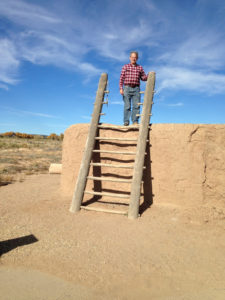 One of the kivas is open for viewing. It is unique partly because it is square, rather than the traditional round room, and partly because the wall paintings were preserved. Apparently painted walls have been found in many historic kivas, but all were destroyed during excavation. The interior walls of this kiva were carefully deconstructed and moved to the Albuquerque Museum. Seventeen layers of paintings were found – apparently from time to time the old paintings were covered with a thick layer of adobe plaster and new paintings created. The paintings that can currently be seen are reconstructions of the originals from the last 2 layers.
One of the kivas is open for viewing. It is unique partly because it is square, rather than the traditional round room, and partly because the wall paintings were preserved. Apparently painted walls have been found in many historic kivas, but all were destroyed during excavation. The interior walls of this kiva were carefully deconstructed and moved to the Albuquerque Museum. Seventeen layers of paintings were found – apparently from time to time the old paintings were covered with a thick layer of adobe plaster and new paintings created. The paintings that can currently be seen are reconstructions of the originals from the last 2 layers.
To enter the kiva, you climb on the roof using a wooden ladder, and then climb down through a hole in the roof using another ladder. In theory, Rumple could have entered the kiva, but the logistics dictated against it. I went down with the guide and a few people who had joined us. Chuck waited with Rumple and then went down with a different guide and the next group.
The interior of the kiva, besides being well decorated, had a number of interesting features including a ventilation shaft, guarded by a low wall, which also shielded the central fire pit and a small alcove meant for sending messages to the heavens. The murals depicted kachinas, eagles, various animals such as snakes, and rain. Apparently the symbols are known to the local Native Americans and are still considered sacred. Photos are not allowed. Our guide has clearly spent a lot of time contemplating the murals and pointed out features such as the commonality among parts of the mural and well-known symbols. It was quite interesting.
The interpretive center also had some artifacts from the Spanish occupation. One interesting set of posters was about Estevan, a Tunisian slave of a Spanish noble who might have been the first westerner to set foot in New Mexico. He survived a shipwreck and went on to become an explorer in his own right.
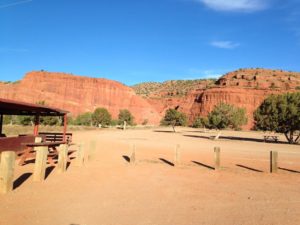
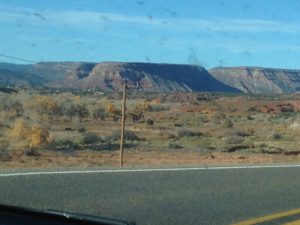
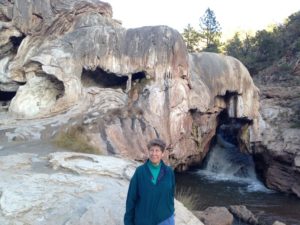
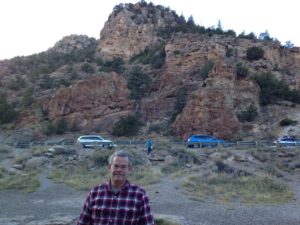 Finishing at the Coronado Historic Site, we continued on to the Jemez Mountain Trail National Scenic Highway. Having bypassed the restaurants in nearby Bernallilo e hoped to find lunch at the next town San Ysidro. This tiny spot has only a church and a few houses, however, so we carried on to the Jemez Pueblo. This village is situated in a gorge of bright red sandstone which make the red soil of PEI look faded. We did not go into the town, which appears to be residential, but a roadside service station served a very palatable lunch which we ate outside while admiring the scenery.
Finishing at the Coronado Historic Site, we continued on to the Jemez Mountain Trail National Scenic Highway. Having bypassed the restaurants in nearby Bernallilo e hoped to find lunch at the next town San Ysidro. This tiny spot has only a church and a few houses, however, so we carried on to the Jemez Pueblo. This village is situated in a gorge of bright red sandstone which make the red soil of PEI look faded. We did not go into the town, which appears to be residential, but a roadside service station served a very palatable lunch which we ate outside while admiring the scenery.
Carrying on from there, we discovered that Jemez Creek cut this very interesting “hole in the rock” waterfall. One interesting feature is that the rocks (including the one I am standing on) are covered in flowstone such as you usually see only in limestone caves. I am not sure why this occurs, but it seems that either the waters of the creek are very mineral rich in this area, or that there is a local deposit of soluble limestone that is quickly redeposited.
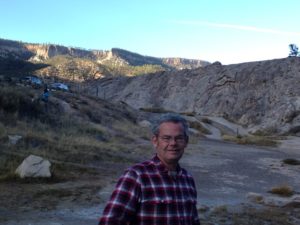 It turns out that the entire area through which the trail wends was formed by successive episodes of volcanism. The mountain range is actually the outer edge of a giant calderon. There is a road to the interior of the calderon, which makes this more apparent, but we did not have time to explore this.
It turns out that the entire area through which the trail wends was formed by successive episodes of volcanism. The mountain range is actually the outer edge of a giant calderon. There is a road to the interior of the calderon, which makes this more apparent, but we did not have time to explore this.
We then continued up the road to the next geological site, which is called Battleship Rock, and is another layer of eruption rock. We did not stop for a photo, but there is a good one at this website. http://www.jemezmountaintrail.org/Jemez_State_Monument.html
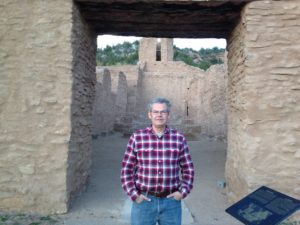 As it was getting late, we decided we had time for only one more stop: the Jemez Historic Site. This is the site of a Spanish Mission, and includes the old basilica and an art gallery.
As it was getting late, we decided we had time for only one more stop: the Jemez Historic Site. This is the site of a Spanish Mission, and includes the old basilica and an art gallery.
With sunset around 5:00, we reluctantly turned back to Albuquerque to avoid being on twisting mountain roads after dark.
However, our adventures for the day were not yet over. While looking for a restaurant for lunch in Bernalillo, Chuck had read a review of the Range Restaurant and decided we needed to go there for dinner. It was a very interesting choice. Bernalillo is not exactly a tourist hotspot, but there in this quiet suburb is this very popular restaurant, wildly decorated with local art. As well it is attached to a large New Mexican artisans’ store. To avoid waiting in line for a table, we decided to sit at the bar. This was a fortuitous choice for two reasons.
Firstly, it turned out that the dessert station was literally right in front of us. Although I am sure they had a pastry chef in the kitchen, the final flourishes to the desserts – swirls of chocolate sauce or whipped cream, sliced fruit or whatever – were prepared right on the counter where we sat. We got to watch dozens of desserts laid out as we ate.
Secondly, the owner of the store plopped down beside us and proceeded to tell us how she had known some of the great pueblo potters and artisans while growing up, had moved away and then returned a few years ago to assist her aged mother with the shop. I still cannot see how this shop can remain in business away from the main shopping area of Albuquerque but both it and the restaurant seem to be well attended.
